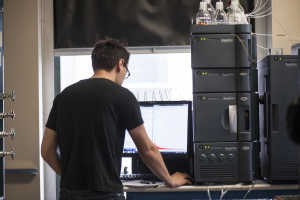Mass Spectrometry at Columbia Chemistry
The mass spectrometry facility in the Department of Chemistry is designed to provide chemists with valuable data quickly and easily. Users can monitor reaction progress by SFC-MS or TLC-MS, identify isolated products by direct injection of solutions into a mass spectrometer, analyze neat oils or insoluble solids with the atmospheric solids analysis probe (ASAP), and characterize large molecules, polymers, and biomolecules with the MALDI TOF. Researchers can also quantify sample concentrations and determine enantiomeric ratios with SFC-MS or SFC-MS/MS. Interested researchers should contact Dr. Fereshteh Zandkarimi, manager of the mass spec facility, for instrument training or submitting samples for accurate mass analysis/high resolution mass spec.
Walk-Up Mass Spec
Walk-up access to the following instruments is given to trained users. If you are interested in using these instruments, sign up for training by adding your name and contact info to the sign-up sheet outside 544 Havemeyer (in the case of the MALDI TOF, contact Dr. Fereshteh Zandkarimi).
- The SFC-MS instrument consists of a Waters SQD2 quadrupole mass spectrometer equipped with a UPC2 SFC inlet, a photodiode array (PDA) UV-vis detector, and a dual ESI/APCI probe (ESI = electrospray ionization, APCI = atmospheric pressure chemical ionization). A column manager houses and automatically switches between 7 different SFC columns and a bypass line (for direct analysis of a sample without chromatography). The columns cover a wide range of chemistries, including two chiral columns for analyzing ratios of stereoisomers. Users can choose from a variety of generic SFC methods or work with a super-user to develop a new method for their specific needs. For more information about the instrument (including sample preparation, submitting samples, and accessing and processing data remotely) check out the SFC-MS User Guide. Installed April 2015.
- The CMS instrument consists of an Advion expression-L CMS quadrupole mass spectrometer equipped with ESI and APCI sources, which can both be used for flow injection analysis and the Plate Express TLC plate reader. The APCI source also includes a port for ASAP. With this multi-functional instrument, users can rapidly analyze solutions by direct injection, identify neat solids or oils by ASAP, or monitor reactions by TLC-MS with the TLC plate reader. Many labs have a group super-user who can help answer common questions and assist with their labmates’ training. A list of lab super-users as well as more information about the instrument can be found in the Advion CMS User Guide. Installed December 2015.
- The MALDI TOF instrument is a Bruker ultrafleXtreme MALDI TOF/TOF with a frequency-tripled Nd:YAG laser (355 nm), linear and reflector modes, and Precursor Ion Selector and LIFT technologies for MS/MS analysis. Interested users should contact Dr. Fereshteh Zandkarimi to schedule a training session, or non-trained researchers may submit samples for analysis by using the Mass Spec Sample Submission Form. Installed December 2016.
Accurate Mass/High Resolution Mass Spec (HRMS)

Alongside the MALDI TOF in 216 Havemeyer, our second HRMS instrument combines many of the functions of the walk-up instruments (SFC, direct infusion, and ASAP modes) but with a QTOF mass spectrometer for accurate mass and MS/MS measurements. The instrument consists of a Waters XEVO G2-XS QToF mass spectrometer equipped with a UPC2 SFC inlet, on-board fluidics, an ESI probe, an APCI probe, and an ASAP. Installed February 2015.
This instrument is not available for walk-up use, so follow the instructions below for submitting a sample for Accurate Mass/HRMS analysis:
- Fill out the Mass Spec Sample Submission Form and email a copy to Dr. Fereshteh Zandkarimi with your sample name in the subject line (for example, “BF123_f4”). If you require any experiment other than routine HRMS analysis, email Dr. Zandkarimi to discuss the experiment before submitting your sample. If you are not currently performing research at Columbia University or Barnard College, you MUST email Dr. Zandkarimi before submitting any samples.
- Only PURIFIED samples may be submitted for routine Accurate Mass analysis. Prepare your sample in a vial or Eppendorf tube, ideally as the neat compound, and label the vial/tube with your sample name. To ensure the highest quality data and the most efficient use of the instrument, you MUST indicate precisely (within 0.5 mg) how much sample you are submitting on the HRMS Sample Submission Form. If the sample must be kept in solution, an accurate concentration must be provided (for example, mg/mL or mM).
- Bring your sample along with a printed copy of the Mass Spec Sample Submission form to Havemeyer 216, and place it on the cart labeled “Submit New Samples Here.” If your sample is air or light sensitive or needs to be kept cold, please speak with Dr. Fereshteh Zandkarimi before bringing your sample down so he can make the proper arrangements.
- The results for your sample will be emailed to you when analysis has been completed.
You can find the HRMS Sample Submission Form on the Forms page under the Facilities tab
